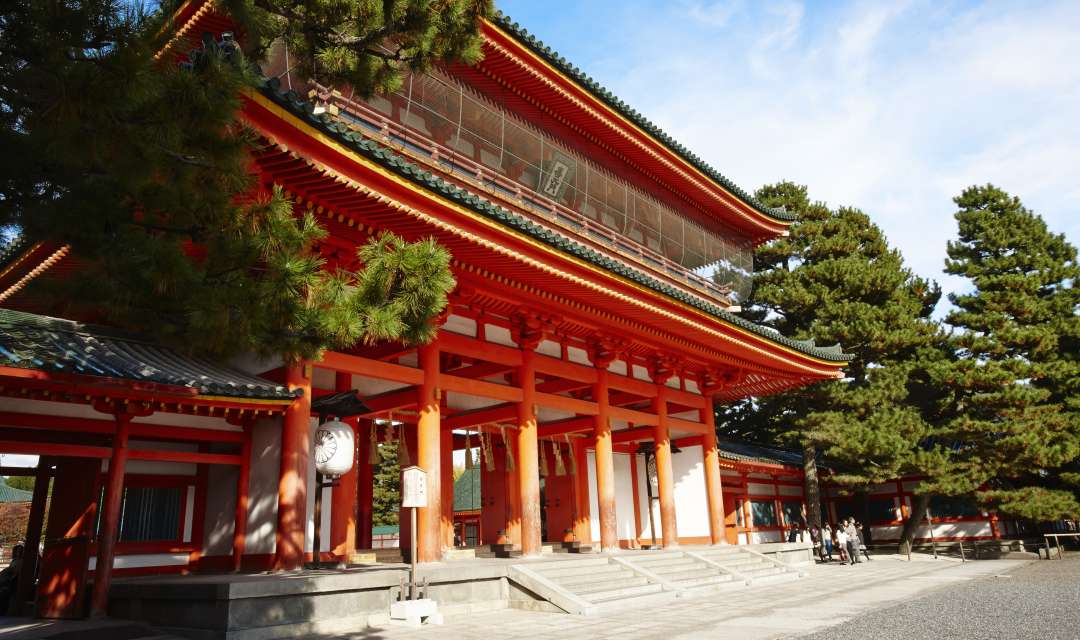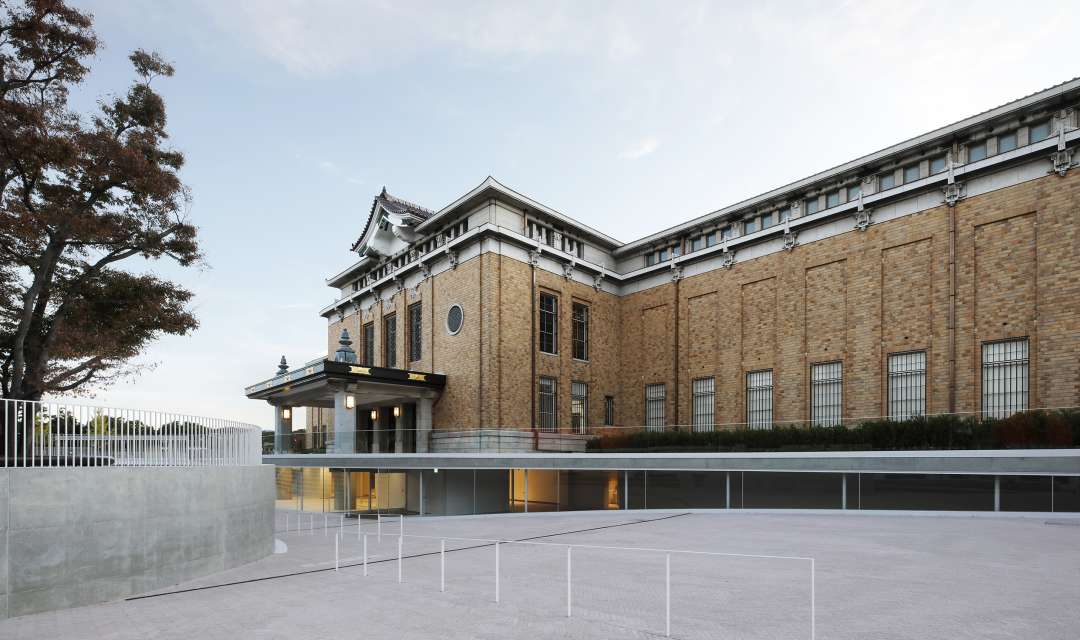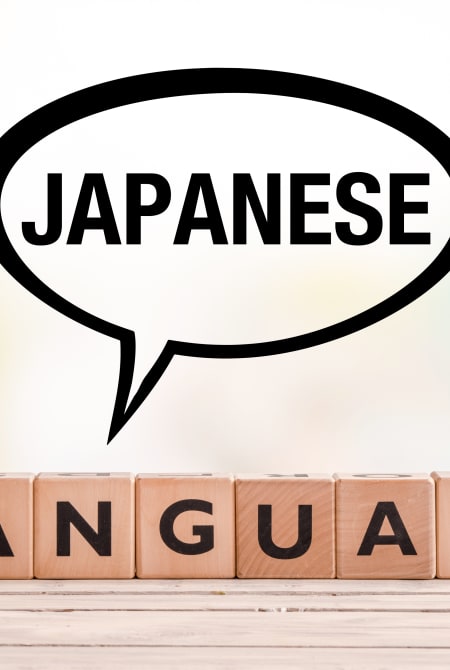Japan’s ancient capital of Kyoto is home to a wealth of culture, art as well as some 1,000 temples and shrines. Undoubtedly, 24 hours in Kyoto is an inadequate amount of time to marvel at all the city has to offer, but this walking itinerary is an excellent way to discover some of its highlights.

Heian-jingu Shrine is a must-visit, even when you're short on time in Kyoto
8:30 am – Ginkaku-ji Temple
Early-morning starts pay off in Kyoto, especially during the peak seasons of spring and autumn. Start your explorations of the ancient capital by heading to Ginkaku-ji, the so-called Silver Temple, located in the Higashiyama hills. Despite the name, the temple may never have been coated silver, as was the wish of the man who built it, the shogun Ashikaga Yoshimasa. Ginkaku-ji dates back to 1490 and is one of the most important monuments to Zen architecture in the city.
The grounds are delightful, and there is always something in bloom, whether camellias or azaleas, the year-round. Souvenir boutiques line the hill path up to the temple, including a kiosk peddling the famous Shogoin Yatsuhashi sweet, a parcel of cinnamon-flavored, glutinous rice with a variety of fillings.

Honen-in Temple's mossy thatching concealed behind foliage makes it a magical spot to visit
9:30 am – Philosopher’s Path
Return to the foot of the hill, and just to the south, you will encounter the trailhead of the Philosopher’s Path, named after the influential professors who taught nearby and took regular, contemplative strolls along the canal here. With some 300 cherry trees along the way, it’s crowded with people during the first week of April but is relatively serene the rest of the year. Several temples and shrines dot the hills along the way, but it is worth veering off the path to pay a visit to Honen-in. This 17th-century temple, shaded by forest, is a haven of moss that grows even on the thatch of the front gate. Local artists often host exhibitions here.
It takes roughly another 30 minutes to reach the end of the path, where your journey continues by road.

The historic Nansen-ji Temple is best known for its impressive gate
10.30 am – Nanzen-ji Temple
Nanzen-ji was once one of the most important temples in Japan, but now its monumental, 22-meter-high Sanmon Gate steals the limelight. It was built in 1620 by one of the generals of the first Tokugawa shogun to appease the souls of those perished in the siege of Osaka Castle and harbors several legends surrounding the fugitive, Ishikawa Goemon. You can climb up the many stairs to where Ishikawa supposedly took refuge until he was caught and, as the story goes, boiled in a pot of oil by the Kamo River. Stop by the Roman-style aqueduct in the northeast corner by the abbot’s hall, which was part of an ambitious 1890s project to bring Kyoto a supply of water from the nearby Lake Biwa, and feels somewhat out-of-place in a temple complex.

Heian-jingu Shrine's gardens are unmissable when in Kyoto
11.30 am – Heian-jingu Shrine
Leave the Nanzen-ji precincts and walk in the direction of the canal for another 20 minutes to the red torii gate that leads up to Heian-jingu Shrine. This 1895 replica of the original imperial palace (albeit not on the original site and a bit smaller) was built as a Shinto shrine to commemorate two of Japan’s emperors, who were the first and last to reign out of Kyoto. It also has wonderful gardens with expansive ponds and is a favorite for herons and egrets. Theatrical Noh performances by firelight take place in the large shrine courtyard in the summer.

Photo: Takeru Koroda. Courtesy of Kyoto City KYOCERA Museum of Art
12.30 pm – Okazaki area
The leafy Okazaki area has been transformed in recent years with the pedestrianization of the stretch up to Heian-jingu Shrine. It is host to many food and antique market events between the spring and autumn, so the chances that you will encounter an event are high. Why not spend your lunch hour here and picnic outside on a beautiful day? The area hosts numerous museums, including the Kyoto City KYOCERA Museum of Art, due to reopen in spring 2020, the Hosomi Museum and The National Museum of Modern Art. One that is hidden away but worth a visit is the Fureaikan Museum, on the basement floor of the Miyako Messe expo hall, which provides a comprehensive look at the rich craft cultures of the region, and often invites local artisans to come and work in the museum for the benefit of visitors.
2 pm – Shirakawa Canal and Gion
Wander south of Okazaki Park, and you will find another charming, willow-lined waterway with quaint stone bridges. Following the Shirakawa for about 30 minutes, you will eventually reach the geisha and entertainment district of Gion. A picturesque scene unfolds at the stretch on Shinbashi Street, where the gently-flowing canal ends. In this area, you will find the beautifully-preserved teahouses that host the exclusive geisha receptions, as well as the shrine of Tatsumi Daimoyojin, dedicated (appropriately) to the goddess of the arts.

Shijo Street is a pretty, leafy street full of boutiques
3 pm – Shijo Street
Just further south of, and parallel to Shinbashi Street is Shijo Street, a hugely popular destination for shopping. The shopping continues on the other side of the Kamo River, with more familiar brand names and large department stores where you can pick up a delectable bento box for dinner at one of the underground food courts.
-
About the author
Lucinda "Ping" Cowing is an Asia travel specialist, and director at the award-winning, non-profit magazine, Kyoto Journal. She lives a nomadic existence, moving between Japan, Taiwan and Portugal.


















































